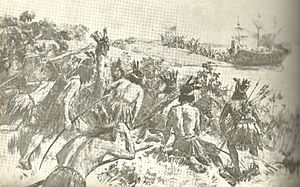Colonial Argentina facts for kids
Colonial Argentina is the name for the time when Argentina was part of the Spanish Empire. This period started when the first Spanish explorers arrived in the lands where native people already lived. It ended when Argentina became independent from Spain.
Contents
European Exploration in Argentina
When Spain and Portugal realized the Americas were a new continent, they decided to divide the land. This was done with the Treaty of Tordesillas. Portugal received a part of eastern South America, and Spain got the rest. However, much of the Americas was still unknown. Many sailors were looking for a passage to the East Indies (Asia) rather than exploring the new continent.

The famous explorer Ferdinand Magellan sailed south along the coast. He found the Strait of Magellan, a passage that allowed his ships to continue west. His journey eventually completed the first trip around the world.
The first explorers in these unknown territories sailed into the wide Río de la Plata. They hoped to find a passage to the west and reach Asia. New explorations were encouraged by stories of silver in the area. These rumors are one of the early reasons for the name of Argentina.
There were also land expeditions coming from the north, from a city called Lima. However, there wasn't much precious metal like gold or silver in the area. Also, there were no large empires like the Aztecs in Mexico or the Incas in Peru. Because of this, not many Spanish people settled in the area at first.
Juan Díaz de Solís Discovers the Río de la Plata
The first European to land in what is now Argentina was Juan Díaz de Solís. He discovered the wide river mouth known as the Río de la Plata. Sadly, Solís and some of his sailors were killed by the Charrúas, a native group. After this, his fleet returned to Spain.
One young sailor named Francisco del Puerto was part of Solís's journey. He was spared by the Charrúas because he was young. He stayed in the Americas for several years.
Sebastian Cabot's Search for Silver
Later, Francisco del Puerto was rescued by a Venetian explorer named Sebastian Cabot. Francisco told Cabot stories about sources of silver in the area. These stories encouraged Cabot to explore further. It turned out there was no silver or other precious metals. But those early myths influenced the modern name of Argentina.
Cabot's journey aimed to conquer the lands of an imaginary "White King." He built a small fort called Sancti Spiritu near the Paraná River. However, his expedition was a complete failure. They didn't find any metals. Sancti Spiritu was destroyed by native people, and the remaining Europeans went back home.
Spanish Colonization of Argentina
The area that is now Argentina was part of several Spanish colonial regions over time:
- The Governorate of New Andalusia (from 1524 to 1542). A "Governorate" was a territory ruled by a governor.
- The Governorate of the Río de la Plata (from 1549 to 1776). This was overseen by the Real Audiencia of Lima in the Viceroyalty of Peru. A "Viceroyalty" was a large territory ruled by a viceroy, who was like a king's representative.
- The Viceroyalty of the Río de la Plata (from 1776 to 1814). This was supervised by the Royal Audiencia of Buenos Aires in the south and the Real Audiencia of Charcas in the north. This lasted until Argentina became independent.
New ideas from the Age of Enlightenment (a period of new ways of thinking) and events like the Peninsular War in Europe led to the Argentine Wars of Independence. These wars were part of the larger Spanish American wars of independence, where many countries in South America fought for their freedom from Spain.
See also
 In Spanish: Conquista y colonización española de la Argentina para niños
In Spanish: Conquista y colonización española de la Argentina para niños
- Viceroyalty of the Río de la Plata topics
- Spanish colonization of the Americas

